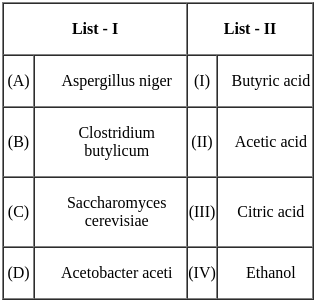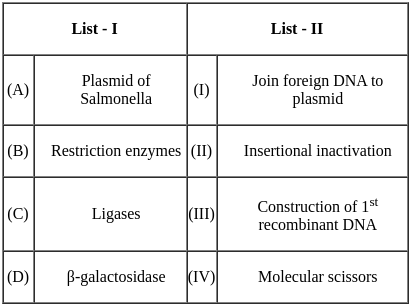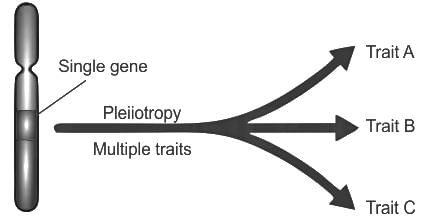Biology: CUET Mock Test - 6 - CUET MCQ
30 Questions MCQ Test - Biology: CUET Mock Test - 6
Match List - I with List - II.

Choose the correct answer from the options given below:

Choose the correct answer from the options given below:
Identify the enzyme used for the isolation of genetic material from fungal cells.
Arrange the following steps of 'Polymerase Chain Reaction' in a correct sequence.
(A) Annealing of primers
(B) Amplified DNA
(C) Denaturation of DNA
(D) Extension of primers
Choose the correct answer from the options given below:
Match List - I with List - II.

Choose the correct answer from the options given below:
Without associating transiently with initiation - factor (σ) and termination - factor (ρ), the RNA polymerase is only capable of catalysing which of the following process ?
1. Initiation
2. Elongation
3. Termination
Consider the following statements.
1. Pleiotropy is the phenomenon of a single gene influencing two or more distinct phenotypic traits.
2. Phenylketonuria is a disease resulting from pleiotropy which is caused by a mutation of the gene.
Which of the statements given above is/are correct?
Which of the following statements are correct?
(A) Penicillin, the first antibiotic, was discovered by Alexander Fleming from the fungus Penicillium.
(B) The production of ethanol by yeast during fermentation is a form of anaerobic respiration.
(C) The sewage treatment process involves the use of aerobic bacteria to break down organic waste.
(D) Biofertilizers improve the fertility of soil by providing nitrogen to the crops.
(E) Industrial fermentation of ethanol and alcoholic beverages involves the use of fungi.
Choose the correct answer from the options given below:
Which of the following statements are correct?
(A) Restriction enzymes are used to cut DNA at specific sites.
(B) Vectors are required to carry the recombinant DNA into the host cell.
(C) A bioreactor is used to culture cells in a controlled environment for large-scale production.
(D) Only bacterial cells are used in recombinant DNA technology.
(E) The insertion of recombinant DNA into the host organism leads to the expression of the foreign gene.
Choose the correct answer from the options given below:
Which of the following statements are correct?
(A) The process of cloning involves creating multiple copies of a gene or DNA segment.
(B) Competent cells are bacterial cells that are treated to take up recombinant DNA.
(C) Vectors must have a high copy number to efficiently propagate recombinant DNA.
(D) Gene therapy involves using genetic engineering to treat genetic disorders in humans.
(E) Restriction enzymes only cut DNA from bacterial sources.
Choose the correct answer from the options given below:
What percentage of human DNA is identical across individuals?
How long did the Human Genome Project take to complete?
What was one of the major implications of the Human Genome Project?
Which of the following was a significant technological advancement during the Human Genome Project?
What is the mechanism proposed by Darwin for evolution?
Where did Darwin observe the variety of finches with different beak shapes?
What happens to advantageous traits in natural selection?
What did Darwin believe about the relationship between species?
Who acts as a pioneering species in a xerarch succession?
Xerarch succession is observed in which of the following area?
What will happen to biomass in an ecological succession from pioneer to climax community?
Which of the following is the correct sequence of xerarch succession?
In a xerarch succession, who helps in weathering and soil formation?















